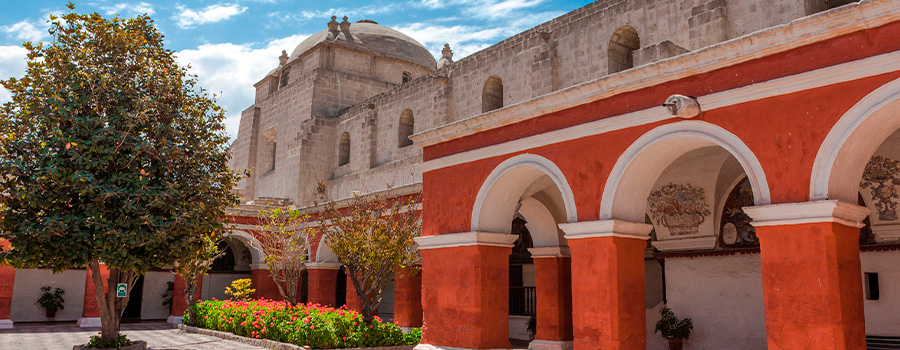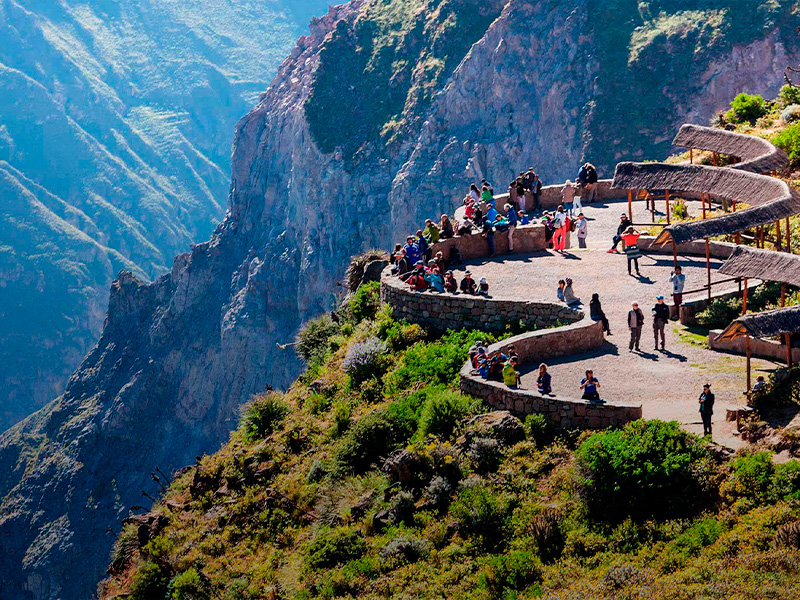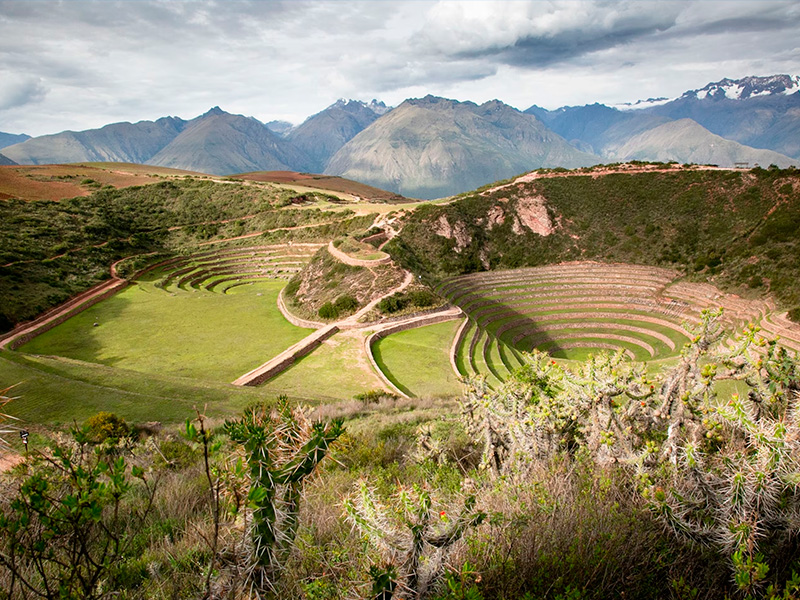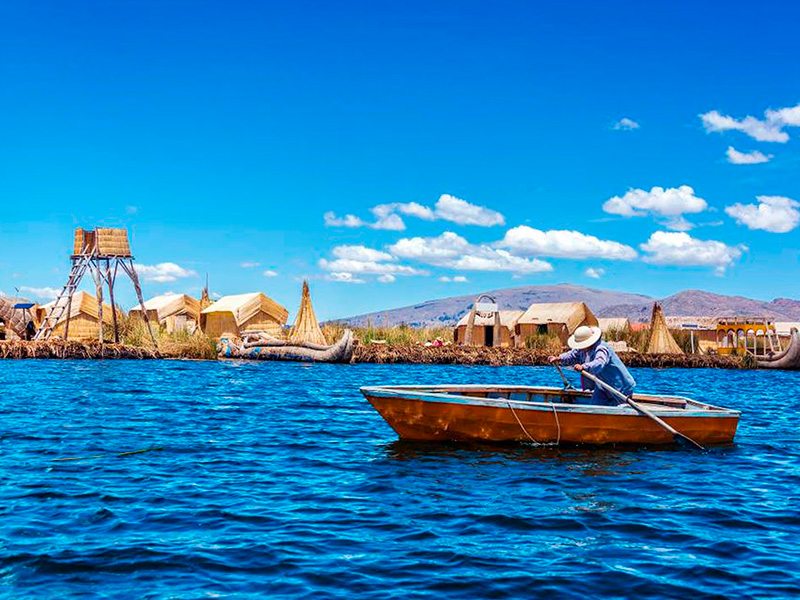
Day 1: Arequipa
Breakfast at the hotel. The morning is dedicated to visiting the beautiful colonial city of Arequipa, known as “the white city,” surrounded by the imposing Misti (5822 m) and Chachani (6075 m) volcanoes, which overlook the wide valley in a stunning setting. Visit the beautiful Plaza de Armas, the Cathedral (which can be visited individually and not with a guide), the interesting baroque churches, the Jesuit Monastery, and the Santa Catalina Monastery, important examples of colonial architecture and among the best-preserved in Peru. Take an excursion to the “Mirador de Yanahuara,” where you can enjoy panoramic views of the city and the surrounding volcanoes. On the way back, visit the pre-Inca terraces of Chilina. Afternoon at leisure for individual visits and shopping. We suggest a visit to the Museum where the pre-Inca mummy, Juanita, is preserved. Overnight stay at the hotel.
Day 2: Arequipa – Chivay
Breakfast at the hotel. Departure for the Colca River Valley (170 km – about 4 hours), ascending the Andean slopes and crossing the Patapampa Pass, located at 4910 meters above sea level. The descent to Chivay (3050 m) passes through the Inca terraces still used by local farmers for the cultivation of corn and potatoes. Visit typical Andean villages with colonial churches and people dressed in splendid traditional costumes, especially women who wear very refined costumes influenced by Spanish colonial fashion. (Optional: Bathing in the thermal waters of La Calera – entrance fee required). Check-in at the hotel and free time. Overnight stay.
Day 3: Colca Canyon – Puno
Breakfast at the hotel. Early in the morning, excursion to the Cruz del Condor to observe the spectacular Colca Canyon, one of the deepest canyons in the world, and the majestic flight of the sacred bird of the Incas, the Andean condor, as it soars through the canyon’s “throat” using the ascending currents of warm air. Departure for Puno (320 km – about 6 hours), crossing the desert plateau known as “puna” at an average altitude of 4000 meters, in the landscape of the Central Andes where colonies of flamingos and Andean camelids can be observed on the edges of colorful lagoons. From the bustling town of Juliaca, continue to visit the pre-Inca necropolis of Sillustani, used by the Tiahuanaco culture for the burial of kings, whose tombs have been partially destroyed by looting and lightning. Continue to Puno, a city located at 3800 meters above sea level, on the shores of Lake Titicaca. Check-in at the hotel. Overnight stay.
Day 4: Lake Titicaca (Taquile Island)
Breakfast at the hotel. According to Andean legend, Manco Capac and Mama Ocllo, the ancestors of the Sun dynasty, emerged from the foam of Lake Titicaca. Together, they set off to new territories in the Andes, giving rise to the culture and history of the Inca people. Visit the floating islands of totora reeds in the Bay of Juli, where the “Uros” people, of Aymara culture, used to live. The islands have become a controversial tourist attraction. Continue navigating Lake Titicaca to reach Taquile Island (3 hours of navigation). Upon arrival at the port, ascend a path cut into the cultivated terraces that leads to the village (we recommend ascending slowly to avoid unnecessary exertion). Free time to get to know the people who have preserved Inca traditions amidst the majestic scenery of Lake Titicaca and the snow-capped mountains of the Cordillera Real. Return by boat to Puno and transfer to the hotel. Free time and overnight stay.
Day 5: Puno – Cusco
Breakfast at the hotel. Continue the journey with the final leg to the city of Cusco (380 km), crossing the arid highlands that gradually ascend to the La Raya Pass (4300 meters above sea level), at the foot of the “Santa Rosa” glacier, where herds of Andean camelids can be observed. Along the way, after Ayaviri, visit the Tinajani Canyon valley to observe the Puja, an endemic plant that the Milanese botanist Antonio Raimondi discovered in the late 19th century in the Chavín de Huantar area, in northern Peru. Descending into the fertile valleys of Sicuani and Cusco, visit the ruins of the temple dedicated to Viracocha, the supreme Inca deity from whom, according to Andean cosmology, the entire universe descends. In the church of Andahuaylillas (17th century), also known as the “Sistine Chapel” of South America, admire the wonderful frescoes by anonymous artists and the golden altars. Arrive in Cusco in the late afternoon and check-in at the hotel. Overnight stay.
Day 6: Cusco – Chincheros – Moray – Maras – Machu Picchu Pueblo
Breakfast at the hotel. Traveling through the scenic highlands of Cusco, dominated by the Salkantay Mountain (6271 m), visit the Andean village of Chincheros, where in the colonial church (which may not always be open to the public) you can admire interesting paintings and frescoes from the famous Cusco colonial painting school of the 17th century. Visit the agricultural terraces of Moray, which recent excavations have revealed to be a production and processing center for freeze-drying potatoes, making them easily transportable throughout the Tawantinsuyo region. Then, visit the spectacular Inca salt mines of Maras, carved into the mountainside, still used today by the villagers for salt extraction. Continue to the Ollantaytambo station and depart in the late afternoon by train to Machu Picchu Pueblo (1 hour and 45 minutes). The journey takes about 1 hour and 45 minutes. Arrive in the small and bustling village located at an altitude of 2040 meters, built around the railway tracks, with shops, bazaars for tourists, pubs, and restaurants of all kinds. Proceed on foot to reach the hotel. Overnight stay. Important: On the trains to/from Machu Picchu Pueblo, only one carry-on baggage (backpack or small bag) weighing a maximum of 8 kg is allowed. Therefore, prepare a carry-on bag with the necessary items for the excursion to Machu Picchu. Please read carefully the code of conduct for visiting Machu Picchu, provided in the useful information section. Entrance to Huayna Picchu is not included. If interested, you must request it at the time of booking.
Day 7: Machu Picchu – Sacred Valley – Cusco
Breakfast at the hotel. “Suddenly we found ourselves amidst a series of buildings covered by the jungle. The walls were made of beautiful white granite, wonderfully cut and fitted together without the need for cement. The site was one surprise after another: we soon realized that we were in the midst of the most marvelous ruins ever found in Peru” (July 24, 1911, Hiram Bingham discovers Machu Picchu). Early in the morning, take a minibus up to Machu Picchu (12 km), at an altitude of 2350 meters. At dawn, you can witness the magical play of the first rays of sun illuminating the stones of the Inca citadel before starting the guided tour of the most important archaeological site in South America, discovered in 1911 by the American explorer Hiram Bingham. In recent years, research on the Inca citadel has shown that Machu Picchu was a “center for agricultural, architectural, and astronomical development” established by Pachacutec, the most important Inca ruler. Return by minibus to Machu Picchu Pueblo and take the train to Ollantaytambo. Upon arrival, meet with the driver/tour leader and continue by land to Cusco (65 km). Check-in at the hotel. Overnight stay.
Day 8: Cusco
Breakfast at the hotel. Located at an altitude of 3350 meters, Cusco, which translates to “the navel of the world” in Quechua, is the ancient capital of the Inca Empire. The archaeological sites, colonial treasures, markets, churches, and squares make Cusco the most fascinating city in South America. Visit the colonial center of Cusco, declared a UNESCO World Heritage Site, with its churches and palaces built on the foundations of Inca temples. Afterward, excursion to the surroundings of Cusco to visit the archaeological sites of Tambomachay and Quenqo, as well as the fortress of Sacsayhuaman. Afternoon at leisure. Overnight stay.
Day 9: Departure from Cusco
Breakfast at the hotel. Morning at leisure for further individual visits to the beautiful city of Cusco or for shopping in the markets and antique shops of the San Blas neighborhood. According to the agreed-upon schedule, transfer to Cusco airport. Departure for the return to Italy (not included) or continuation for optional extensions.
INCLUDED
- CUSCO AIRPORT PICKUP/DROPOFF
Motorcycle (choose from Honda XR150L, XR190CT, XRE300, Suzuki DR650) - Adventure Guide (english/spanish)
- Basic insurance (“SOAT” for personal injury related to a traffic accident)
8 nights accommodation based on double occupancy. 3-star with breakfast included (Santa Teresa and Lares is 2-star, breakfast arranged by Manu Wonderland Tours), based on double-occupancy - Transfer Santa Teresa to Hidroelectrica, Train Hidroelectrica<->Aguas Calientes, Shuttle bus Aguas Calientes<->Machu
Picchu, Entrance fee Machu Picchu, Cultural Guide Machu Picchu - Zipline Adventure at Vertikal in Santa Teresa
- Airport pickup and dropoff
NOT INCLUDED
- Gasoline (for riders or guide). The guide’s gasoline cost is split amongst the riders
- Entrance fees for any of the sites/optional activities
- Motorcycle Clothing and Accessories (available for rental)
PRICES for Inca Road 8 Days
$4700 per person
EXTRAS
Huayna Picchu Mountain – US$20 per person (Please request when you book your Trek)



